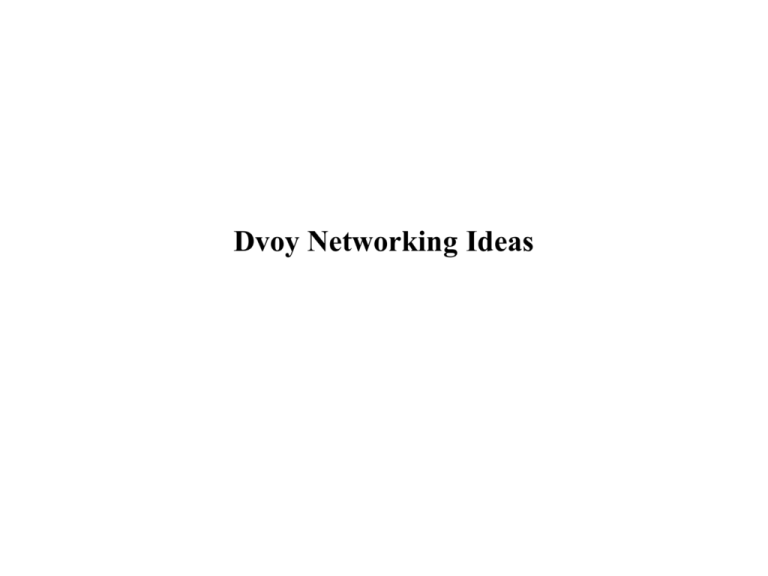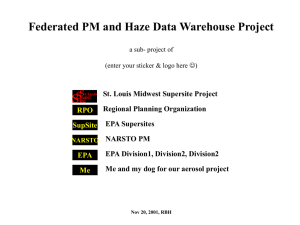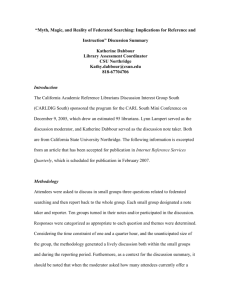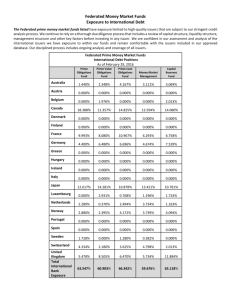DvoyNetworkIdeas
advertisement

Dvoy Networking Ideas OpenGIS Web Services • • • • Mission: Definition and specification of geospatial web services. A Web service is an application that can be published, located, and dynamically invoked across the Web. Applications and other Web services can discover and invoke the service. The sponsors of the Web services initiative include – – – – – – – – • Federal Geographic Data Committee Natural Resources Canada Lockheed Martin National Aeronautics and Space Administration U.S. Army Corps of Engineers Engineer Research and Development Center U.S. Environmental Protection Agency EMPACT Program U.S. Geological Survey US National Imagery and Mapping Agency. Phase I - February 2002 – – – Common Architecture: OGC Services Model, OGC Registry Services, and Sensor Model Language. Web Mapping: Map Server- raster, Feature Server-vector, Coverage Server-image, Coverage Portrayal Services. Sensor Web: OpenGIS Sensor Collection Service for accessing data from a variety of land, water, air and other sensors. D-DADS Architecture The D-DADS Components • Data Providers supply primary data to system, through SQL or other data servers. • Standardized Description & Format populate and describe the data cubes and other data types using a standard metadata describing data • Data Access and Manipulation tools for providing a unified interface to data cubes, GIS data layers, etc. for accessing and processing (filtering, aggregating, fusing) data and integrating data into virtual data cubes • Users are the analysts who access the D-DADS and produce knowledge from the data The multidimensional data access and manipulation component of D-DADS will be implemented using OLAP. Interoperability One requirement for an effective distributed environmental data system is interoperability, defined as, “the ability to freely exchange all kinds of spatial information about the Earth and about objects and phenomena on, above, and below the Earth’s surface; and to cooperatively, over networks, run software capable of manipulating such information.” (Buehler & McKee, 1996) Such a system has two key elements: • Exchange of meaningful information • Cooperative and distributed data management On-line Analytical Processing: OLAP • A multidimensional data model making it easy to select, navigate, integrate and explore the data. • An analytical query language providing power to filter, aggregate and merge data as well as explore complex data relationships. • Ability to create calculated variables from expressions based on other variables in the database. • Pre-calculation of frequently queried aggregated values, i.e. monthly averages, enables fast response time to ad hoc queries. User Interaction with D-DADS Query XML data Distributed Database Data View (Table, Map, etc.) XML data Metadata Standardization Metadata standards for describing air quality data are currently being actively pursued by several organizations, including: • The Supersite Data Management Workgroup • NARSTO • FGDC Potential D-DADS Nodes The following organizations are potential nodes in a distributed data analysis and dissemination system: • CAPITA • NPS-CIRA • EPA Supersites - California - Texas - St. Louis Summary In the past, data analysis has been hampered by data flow resistances. However, the tools and framework to overcome each of these resistances now exist, including: • World Wide Web • XML • OLAP • OpenGIS • Metadata standards Incorporating these tools will initiate a distributed data analysis and dissemination system. ‘Global’ and ‘Local’ AQ Analysis • • • • • AQ data analysis needs to be performed at both global and local levels The ‘global’ refers to regional national, and global analysis. It establishes the larger-scale context. ‘Local’ analysis focuses on the specific and detailed local features Both global and local analyses are needed for for full understanding. Global-local interaction (information flow) needs to be established for effective management. National and Local AQ Analysis Data Re-Use and Synergy • • • Data producers maintain their own workspace and resources (data, reports, comments). Part of the resources are shared by creating a common virtual resources. Web-based integration of the resources can be across several dimensions: Spatial scale: Data content: Local – global data sharing Combination of data generated internally and externally Local Local User Shared part of resources User Content Virtual Shared Resources User Data, Knowledge Tools, Methods Content User Global • • Global User The main benefits of sharing are data re-use, data complementing and synergy. The goal of the system is to have the benefits of sharing outweigh the costs. Integration for Global-Local Activities Global and local activities are both needed – e.g. ‘think global, act local’ ‘Global’ and ‘Local’ here refers to relative, not absolute spatial scale Global Activity Local Benefit Global data, tools Improved local productivity Global data analysis Spatial context; initial analysis Analysis guidance Standardized analysis, reporting Local Activity Global Benefit Local data, tools Improved global productivity Local data analysis Elucidate, expand initial analysis Identify relevant issues Responsive, relevant global analysis Content Integration for Multiple Uses (Reports) Data from multiple measurements are shared by their providers or custodians Data are integrated, filtered, aggregated and fused in the process of analysis Reports use the analysis for Status and Trends; Exposure Assessment; Compliance … The creation of the needed reports requires data sharing and integration from multiple sources. Federated Data Warehouse Features • As much as possible, data should reside in their respective home environment. ‘Uprooted’ data in decoupled databases tend to decay i.e. can not be easily updated, maintained, enriched. • Data Providers would need to ‘open up’ their SQL data servers for limited data subsets and queries, in accordance with a ‘contract’. However, the data structures of the Providers will not need to be changed. • Data from the providers will be transferred to the ‘federated data warehouse’ through (1) on-line DataAdapters, (2) Manual web submission and (3) Semi-automated transfer from the NARSTO archive. • Retrieval of uniform data from the data warehouse facilitates integration and comparison along the key dimensions (space, time, parameter, method) • The open architecture data warehouse (see Web Services) promotes the building of further value chains: Data Viewers, Data Integration Programs, Automatic Report Generators etc.. DVoy: Components and Data Flow Presentation Services Navigation Service Catalog Service DataSet Recs Time Chart DataSet Records • Provider Descript. Selected Measure Record Find (Measure) • Service Descript. • Measure Access FocusCube, GlobCursor, Layered Map Data Services Data Delivery Publish WebService (DataSet) Data Delivery WebService Measure, Granule Data Wrapping DataToView DataForCursorAndView • Dvoy Bind (Measure, FocusCube) WebService Legacy Data Viewer Layers Cursor Data provided by each dimension of a View: Dim1: Lon Data Focus Range Dim2: Lat Dim1.Type, Dim1.Min, Dim1.Max Dim2.Type, Dim2.Min, Dim2.Max Rendering …. Current Dim.Types: Latitude, Longitude, DateTime, Elevation Federated Data Services Architecture XDim Data SQL Table XML Web Services Data Warehouse Tier OLAP Cube Data View & Process Tier Layered Map GIS Data Satellite OpenGIS Services Vector Connection Cursor-Query Manager Manager Data Access Data View Manager Manager Cursor Time Chart Text, Table Scatter Chart Text Data Web Page HTTP Services Text Data Distributed data of multiple types (spatial, temporal text) The Broker handles the views, connections, data access, cursor Data are rendered by linked Data Views (map, time, text) Dvoy Federated Information System • Dvoy offers a homogeneous, read-only access mechanism to a dynamically changing collection of heterogeneous, autonomous and distributed information sources. • Data access uses a global multidimensional schema consisting of spatial, temporal and parameter dimensions • The uniform global schema is suitable for data browsing and online analytical processing, OLAP • The limited global query capabilities yield slices along the spatial, temporal and parameter dimensions of the multidimensional data cubes. Architecture of DATAFED Federated Data System After Busse et. al., 1999 • The main software components of Dvoy are wrappers, which encapsulate sources and remove technical heterogeneity, and mediators, which resolve the logical heterogeneity. • Wrapper classes are available for geo-spatial (incl. satellite) images, SQL servers, text files,etc. The mediator classes are implemented as web services for uniform data access to n-dimensional data. Integration Architecture (Ullman, 1997) • • • Heterogeneous sources are wrapped by software that translates between the sources local language, model and concepts and the shared global concepts Mediators obtain information from one or more components (wrappers or other mediators) and pass it on to other mediators or to external users. In a sense, a mediator is a view of the data found in one or more sources; it does not hold the data but it acts as it it did. The job of the mediator is to go to the sources and provide an answer to the query. Federated PM and Haze Data Warehouse Project a sub- project of (enter your sticker & logo here ) St. Louis Midwest Supersite Project RPO Regional Planning Organization SupSite EPA Supersites NARSTO NARSTO PM EPA EPA Division1, Division2, Division2 Me Me and my dog for our aerosol project Nov 20, 2001, RBH PM/Haze Data Flow in Support of AQ Management FLM RPO FLM RPO FLM RPO Federal Land Managers Regional Planning Orgs EPA EPA EPA EPA Regul. & Research Shared PM/Haze Data SuperSite NARSTO Industry Academic Other: Private, Academic • PM and haze data are used for may parts of AQ management, mostly in form of Reports • There are numerous organizations in need of data relevant to PM/Haze • The variety of pertinent (ambient, emission) data come from many different sources • Most interested parties (stakeholders) are both producers and consumers of PM and haze data • To produce relevant reports, the data need to be ‘processed’ (integrated, filtered aggregated) • There is a general willingness to share data but the resistances to data flow and processing are too high Scientific and Administrative Rationale for Resource Sharing • • • • Scientific Rationale: Regional haze and its precursors have a 1000-10000 km airshed. (Smoke, Dust, Haze) – Data integration Substantial fraction of haze originates from natural sources or from out-of-jurisdiction man-made sources Cross-RPO data and knowledge sharing yields better operational and science support to AQ management Management Rationale: • Haze control within some RPOs cannot yield • Data sharing saves money and …. A Strategy for the Federated PM/Haze Data Warehouse • Negotiate with the data providers ‘open up’ their data servers for limited, controlled, access in accordance with clear ‘access contract’ with the Federated Warehouse • Design an interface to the warehoused datasets that has simple data access and satisfies the data needs of most integrating users.(oxymoron ????) • Facilitate the the development of shared value-adding processes (analysis tools, methods) that refine the raw data to useful knowledge Three-Tier Federated Data Warehouse Architecture (Note: In this context, ‘Federated’ differs from ‘Federal’ in the direction of the driving force. Federated meant to indicate a driving force for sharing from ‘bottom up’ i.e. from the members, not dictated from ‘above’, by the Feds) 1. Provider Tier: Back-end servers containing heterogeneous data, maintained by the federation members 2. Proxy Tier: Retrieves designated Provider data and homogenizes it into common, uniform Datasets 3. User Tier: Accesses the Proxy Server and uses the uniform data for presentation, integration or Federated Data Warehouse processing User Tier Data presentation, processing Proxy Tier Data homogenization, transformation Provider Tier Heterogeneous data in distributed SQL Servers Federated Data Warehouse Interactions • The Provider servers interact only with the Proxy Server in accordance with the Federation Contract – The contract sets the rules of interaction (accessible data subsets, types of queries) – Strong server security measures enforced, e.g. through Secure Socket layer • The data User interacts only with the generic Proxy Server using flexible Web Services interface – Generic data queries, applicable to all data in the Warehouse (e.g. data sub-cube by space, time, parameter) Federated Data Warehouse – The data query is addressed to the Web Service provided by the Proxy Server – Uniform, self-describing data packages are passed the user for presentation or further ProxytoTier Provider Tier User Tier processing Heterogeneous Data Data Consumption Data Homogenization, etc. Presentation SQLDataAdapter1 SQLServer1 Processing SQLDataAdapter2 SQLServer2 Integration CustomDataAdapter LegacyServer Data Access & Use Proxy Server Member Servers Web Service, Uniform Query & Data Fire Wall, Federation Contract ‘Global’ and ‘Local’ AQ Analysis • • • • • AQ data analysis needs to be performed at both global and local levels The ‘global’ refers to regional national, and global analysis. It establishes the larger-scale context. ‘Local’ analysis focuses on the specific and detailed local features Both global and local analyses are needed for for full understanding. Global-local interaction (information flow) needs to be established for effective management. National and Local AQ Analysis Data Model Ray Plante, Virtual Obs • What’s the difference between Data Models and Metadata? Intertwined – metadatum: a datum with a name or semantic tag that refers to the data – data model: a description of the relationships between metadata • structural & logical relationships between compound objects & their components • operations that can be performed on them (really - – framework: the architecture/process used to define metadata/data models that enables their ready use in applications • Formalized data modeling process – encourages community involvement for defining standard models & metadata – structure enables easy verification, dissemination, & automated use – “standard” metadata should point directly to components of the “standard” models – allow groups to define metadata independent of a “standard” metadata • Practical Difference? – data model captures as complete a picture of a concept as possible – metadata represents the instantiation of portion of the model’s components • Data access through a data model (Wrapper Classes for each data model) Integration for Global-Local Activities Global and local activities are both needed – e.g. ‘think global, act local’ ‘Global’ and ‘Local’ here refers to relative, not absolute scale Global Activity Local Benefit Global data, tools => Improved local productivity Global data analysis => Spatial context; initial analysis Analysis guidance => Standardized analysis, reporting Local Activity Global Benefit Local data, tools => Improved global productivity Local data analysis => Elucidate, expand initial analysis Identify relevant issues => Responsive, relevant global work Federated Data System Features • Data reside in their respective home environment where it can mature. ‘Uprooted’ data in centralized databases are not easily updated, maintained, enriched. • Abstract (universal) query/retrieval facilitates integration and comparison along the key dimensions (space, time, parameter, method) • The open data query based on Web Services promotes the building of further value chains: Data Viewers, Data Integration Programs, Automatic Report Generators etc.. • The data access through the Proxy server protects the data providers and the data users from security breaches, excessive detail Integration for Global-Local Activities Global and local activities are both needed – e.g. ‘think global, act local’ ‘Global’ and ‘Local’ here refers to relative, not absolute spatial scale Global Activity Local Benefit Global data & analysis Spatial context; initial analysis Analysis guidance Standardized analysis, reporting Local Activity Global Benefit Local data & analysis Elucidate, expand initial analysis Identify relevant issues Responsive, relevant global analysis Data Re-Use and Synergy • • • Data producers maintain their own workspace and resources (data, reports, comments). Part of the resources are shared by creating a common virtual resources. Web-based integration of the resources can be across several dimensions: Spatial scale: Data content: Local – global data sharing Combination of data generated internally and externally Local Local User Shared part of resources User Content Virtual Shared Resources User Data, Knowledge Tools, Methods Content User Global • • Global User The main benefits of sharing are data re-use, data complementing and synergy. The goal of the system is to have the benefits of sharing outweigh the costs. Federated Information System • • • Providers maintain their own workspace and resources (data, tools, reports) Part of the private resources are exposed as shared (federated) resources The Federation facilitates finding, accessing and usage of the shared resources Data Providers/Users Other Federations Data sharing federations: • • • • Open GIS Consortium (GIS data layers) NASA SEEDS network (Satellite data) NSF Digital Government EPA’s National Env. Info Exch. Network. Info Shared Private Shared (Federated) Resources Data, Services, Tools, Methods Data Federation Concept and the FASNET Network Schematic representation of data sharing in a federated information system. Based on the premise that providers expose part of their data (green) to others Schematics of the value-adding network proposed for FASTNET Components embedded in the federated value network Data Acquisition and Usage Value Chain Monitor Data 1 Store IntData1 Monitor Data 2 Store IntData2 Monitor Data n Store Monitor Data m Store IntDatan Virtual Int. Data Processes of the Information Value Chain (after Taylor, 1975) Organizing Analyzing Judging Deciding Grouping Classifying Formatting Displaying Separating Evaluating Interpreting Synthesizing Options Quality Advantages Disadvantages Matching goals, Compromising Bargaining Deciding Data Examples: • Information CIRA VIEWS Informing Knowledge Langley IDEA Productive Knowledge WG Summary Rpt Action AQ Manager Data Flow and Processing Not There! Further Analysis When? Where? CATT: A Community Tool! GIS Part of an Analysis Value Chain Grid Processing Emission Why? There! Comparison How? AEROSOL Collection IMP. EPA Aerosol Sensors Integration VIEWS Aerosol Data CATT-In CAPITA Integrated AerData AerData Cube Aggreg. Aerosol Next Process CATT Weather Data Gridded Meteor. Assimilate NWS TRANSPORT Traject. Data Trajectory ARL TrajData Cube CATT-In CAPITA Aggreg. Traject. Next Process Fast Aerosol Sensing Tools for Natural Event Tracking FASTNET Analysts Console Community Website Distributed Programming: Interpreted and Compiled • Web services allow processing of distributed data – Data are distributed and maintained by their custodians, – Processing nodes (web-services) are also distributed – ‘Interpreted’ web-programs for data processing can be created ad hoc by end users • However, ‘interpreted’ web programs are slow, fragile and uncertain – Slow due to large data transfers between nodes – Fragile due to instability of connections – Uncertain due to failures of data provider and processing nodes • One solution is to ‘compile’ the data and processing services – Data compilation transforms the data for fast, effective access (e.g. OLAP) – Web service compilation combines processes for effective execution • Interpreted or compiled? – Interpreted web programs are simpler and up to date but slow, fragile, uncertain – Compiled versions are more elaborate and latent but also faster and more robust – Frequently used datasets and processing chains should be compiled and kept current Interpreted and Compiled Service Interpreted Service • Processes distributed Point Access • Data flow on Internet Point Grid Grid Render Point Access Point Render PtGrid Overlay Data Flow Control Flow Compiled Service • Processes in the same place Point Access Point Grid Grid Render • Data flow within aggregate service • Controllers, e.g. zoom can be shared Point Render PtGrid Overla y Voyager: The Program Controls Ports Voyager Core Data Selection Data Access Data Portrayal Device Drivers Displays Wrapper s Data Sources Adoptive Abstract I/O Layer • The Voyager program consists of a stable core and adoptive input/output section • The core executes the data selection, access portrayal tasks • The adoptive, abstract I/O layer connects the core to evolving web data, flexible displays and to the a configurable user interface: – Wrappers encapsulate the heterogeneous external data sources and homogenize the access Dvoy_Services: Generic Software components User Interface Module UIM extracts relevant UI parameters from STATE User Interface Module User changes UI parameters UIM transmits modified UI parameters to STATE Controller state I/o ports Service Chain STATE Module Contains the state params for all services in the chain Service state Has ports for getting/setting state params state I/o ports Web service Input data Webservice Service Adopter Module Gets input data from upsteam service Adaptor Gets service params from STATE Web service calls Make service call Web service Service Module Webservice Param 1 Param2 Gets service call from Adopter module Web service Output data Executes service Returns output data Service Adopter Module PointAccess->Grid->GridRender Service Chain GetMapPointData Selector RenderMapviewPoint Selector state I/o ports Service state Service state state I/o ports GetMapPointData Adaptor RenderMapviewPoint Adaptor Web service calls GetMapPointData dataset_abbr: IMPROVE Param_abber SOILf datatime: 2001-04-16 sql_filter: • RenderMapviewPoint Web service Output data dataset_url: output_format: out_image_width: Etc….. The service chain interpreter make ONLY 2 sequential calls, stated in the data flow program: – – GetMapPointDataAdaptor RenderMapviewPoint Adaptor PointAccess->Grid->GridRender Service Chain GridMapviewPoint Selector GetMapPointData Selector RenderMapviewGrid Selector state I/o ports Service state Service state Service state GridMapviewPoint Adaptor RenderMapviewGrid Adaptor GridMapviewPoint RenderMapviewGrid state I/o ports GetMapPointData Adaptor Web service calls GetMapPointData dataset_abbr: IMPROVE • Web service Output data dataset_url: dataset_url: Param_abber SOILf output_format: output_format: datatime: 2001-04-16 out_image_width: out_image_width: sql_filter: Etc….. Etc….. The service chain interpreter make ONLY 3 sequential calls, stated in the data flow program: – GetMapPointDataAdaptor – GridMapviewPointAdaptor – RenderMapviewGridAdaptor VOYAGER Web Services C O M M U N I T Y XDim Data SQL Tables Layered Map Publish, Find, Bind GIS Data Vector Time Chart Catalog, Data & Tools Uniform Access Web Scatter Chart Images Providers Voyager Web Services Users Maintain distributed data; Heterogeneous coding , access Homogenize data access Catalog, access, transform data Select, Overlay, Explore; Multidimensional data Coordination S u p p o r t Technologies Services Program Execution: Reverse Polish Notation Writing the WS program: - Write the program on the command line of a URL call - Services are written sequentially using RPN - Replacements Connector/Adaptor: - Reads the service name from the command line and loads its WSDL - Scans the input WSDL - The schema walker populates the service input fields from: - the data on the command line - the data output of the upstream process - the catalog for the missing data Service Execution For each service Reads the command line, one service at a time Passes the service parameters to the above Connector/Adopter, which prepares the service Executes the service It also handles the data stack for RPN






